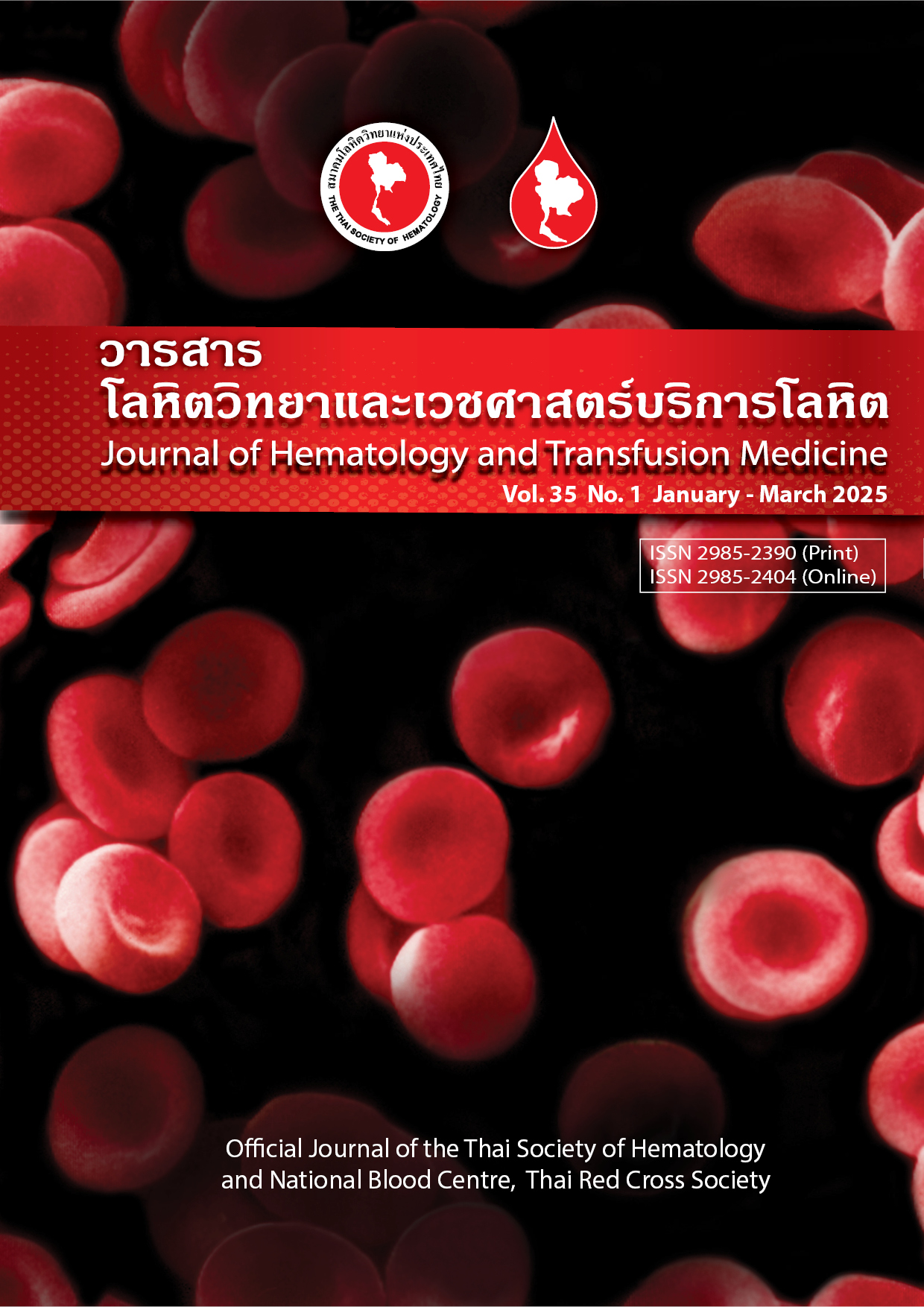Case report of a Thai blood donor with weak expression of RHCE antigens
Keywords:
RHCE blood group, Adsorption-elution, Titration, Next-generation sequencing, หมู่โลหิตระบบ Rh(CE), การไทเทรตAbstract
Abstract:
The Rh blood group is encoded by the RHCE gene, including C, E, c, and e, which are clinically important in causing hemolytic transfusion reactions (HTRs) and hemolytic disease of the fetus and newborn (HDFN). In this report, we present a case of weak expression of C, E, c, and e antigens in a Thai blood donor. The donor's RHCE antigens were tested using standard serological methods with monoclonal antibodies from two different clones using the column agglutination test (CAT) method by Ortho Vision Max analyzer. The blood donor result using the first clone of monoclonal antibodies was C-E-c-e- and using the second clone of monoclonal antibodies was C+E-c-e-. Differences between the two monoclonal antibody clones' results were observed, therefore using other serological techniques, adsorption-elution and titration, and the molecular technique, next-generation sequencing (NGS) combined with genetic inheritance studies, to be able to confirm RHCE antigens results. It was found that the blood donor and her parents had a hybrid of RHD and RHCE genes, which the predicted hybrid is possibly RHCE(1-2)-D(3-7)-CE(8-10) or RHCE(1)-D(2-8)-CE(9-10) or RHCE(1-2)-D(3-8)-CE(9-10) or RHCE(1)-D(2-7)-CE(8-10). This may be causing reduced or lack of expression of some or all of the RHCE antigens. The predicted phenotype of the blood donor and her parents was C+E-c-e+. Due to this testing cannot definitively identify the variant's location, further testing using long-read sequencing is required to confirm the position of the hybrid gene.
บทคัดย่อ
หมู่โลหิตระบบ Rh ที่เกิดจากยีน RHCE คือแอนติเจน C, E, c และ e มีความสำคัญทางคลินิกในการทำให้เกิด hemolytic transfusion reaction (HTRs) และ hemolytic disease of the fetus and newborn (HDFN) รายงานนี้เป็นการศึกษาการแสดงออกของแอนติเจน C, E, c และ e ที่ผิดปกติในผู้บริจาคโลหิต 1 ราย โดยตรวจแอนติเจน RHCE ในผู้บริจาคโลหิตด้วยเทคนิคการตรวจทางซีโรโลยีที่เป็นมาตรฐานในงานธนาคารเลือด ด้วยน้ำยา monoclonal antibody ที่แตกต่างกัน 2 clones ด้วยวิธี column agglutination test (CAT) โดยใช้เครื่องวิเคราะห์อัตโนมัติ Ortho Vision Max ผลการตรวจแอนติเจนในผู้บริจาคโลหิตพบว่าน้ำยา clone ที่ 1 ได้ผลเป็น C-E-c-e- และ clone ที่ 2 ได้ผลเป็น C+E-c-e- ซึ่งผลของน้ำยา monoclonal 2 clones ขัดแย้งกัน ดังนั้น จึงใช้เทคนิคการตรวจทางซีโรโลยีอื่นๆ คือ adsorption-elution และ titration และเทคนิคด้านอณูชีววิทยา คือ next-generation sequencing ร่วมกับการศึกษาการถ่ายทอดทางพันธุกรรมร่วมด้วย จึงสามารถสรุปผลแอนติเจนของผู้บริจาคได้ถูกต้อง ผลการตรวจทางด้านอณูชีววิทยาพบว่า ผู้บริจาคโลหิต บิดาและมารดา มียีนลูกผสมของ RHD และ RHCE genes ที่เป็นไปได้คือ RHCE(1-2)-D(3-7)-CE(8-10) หรือ RHCE(1)-D(2-8)-CE(9-10) หรือ RHCE(1-2)-D(3-8)-CE(9-10) หรือ RHCE(1)-D(2-7)-CE(8-10) ซึ่งน่าจะเป็นสาเหตุของการลดลงของการแสดงออกของแอนติเจน RHCE โดยความน่าจะเป็นของแอนติเจนของผู้บริจาคโลหิต บิดาและมารดาคือ C+E-c-e+ แต่ผลการทดสอบไม่สามารถระบุตำแหน่งของ variant ได้อย่างแน่ชัด ต้องทำการทดสอบเพิ่มเติมโดยเทคนิค long read sequencing เพื่อยืนยันตำแหน่งของยีนลูกผสมต่อไป
Downloads
References
Avent ND, Reid ME. The Rh blood group system: a review. Blood. 2000;95 (Suppl 2):S375–87.
Agre P, Cartron JP. Molecular biology of the Rh antigens. Blood. 1991;78 (Suppl 3):S551-63.
Daniels G. Human blood groups. Chichester: Wiley-Blackwell; 2013.
Mouro I, Colin Y, Cherif-Zahar B, Cartron JP, Le Van Kim C. Molecular genetic basis of the human Rhesus blood group system. Nature Genetics. 1993;5:62–5.
Dean L. Blood groups and red cell antigens. Bethesda, MD: National Center for Biotechnology Information (US); 2005.
Flegel WA, Wagner FF. Molecular genetics of RH. Vox Sang. 2000;78 (Suppl 2):109–15.
Sippert E, Arnoni CP, Rios M. Impact of RHCE variability and complexity in transfusion medicine: a narrative review. Ann Blood. 2023;8:8. doi: 10.21037/aob-21-76.
Wagner FF, Flegel WA. Review: the molecular basis of the Rh blood group phenotypes. Immunohematology. 2004;20 (Suppl 1):S23-36.
Westhoff CM. The Rh blood group system in review: a new face for the next decade. Transfusion. 2004;44 (Suppl 11):S1663-73.
Chérif-Zahar B, Mattéi MG, Le Van Kim C, Bailly P, Cartron JP, Colin Y. Localization of the human Rh blood group gene structure to chromosome region 1p34.3-1p36.1 by in situ hybridization. Human Genetics. 1991;86 (Suppl 4):398–400.
Cohn CS, Delaney M, Johnson ST, Katz LM, Schwartz J, editor. Technical Manual. 21st ed. Bethesda, MD: American Association of Blood Banks; 2023.
Reid ME, Lomas-Francis C, Olsson ML. The blood group antigen: FactsBook. 3rd ed. Boston: Academic Press; 2012.
Johnson ST, Judd WJ, Storry JR, editors. Judd’s methods in immunohematology. 4th ed. Basel: S Karger AG; 2008.
Anderson MW, Schrijver I. Next generation DNA sequencing and the future of genomic medicine. Genes (Basel). 2010;1 (Suppl 1):38-69.
Schoeman EM, Lopez GH, McGowan EC, Millard GM, O'Brien H, Roulis EV, et al. Evaluation of targeted exome sequencing for 28 protein-based blood group systems, including the homologous gene systems, for blood group genotyping. Transfusion. 2017;57:1078-88.
Downloads
Published
Issue
Section
License
Copyright (c) 2025 Journal of Hematology and Transfusion Medicine

This work is licensed under a Creative Commons Attribution-NonCommercial-NoDerivatives 4.0 International License.


